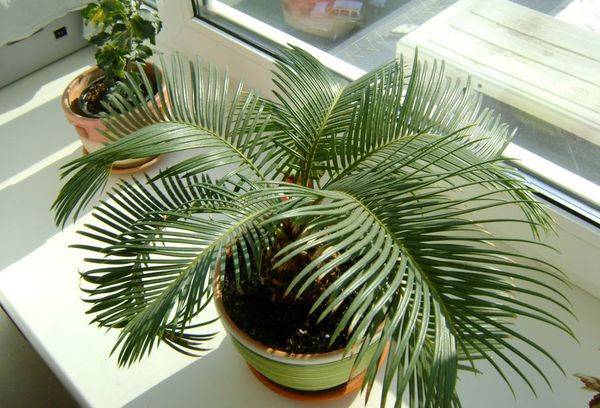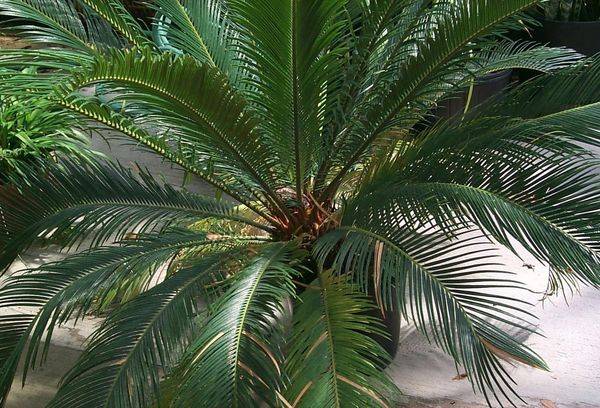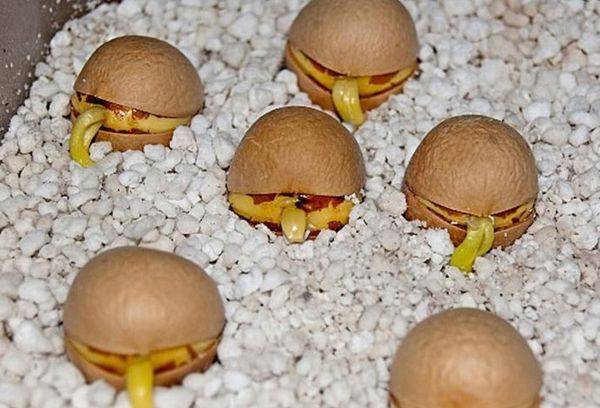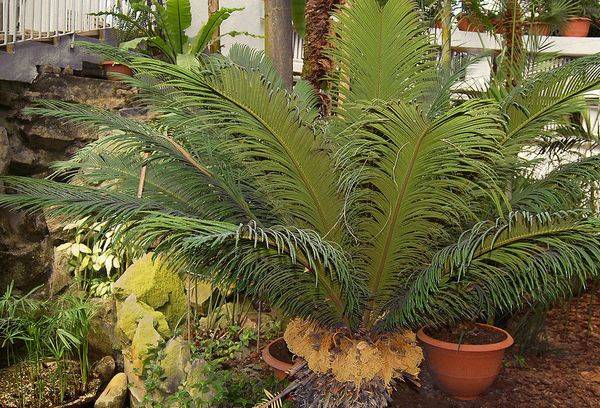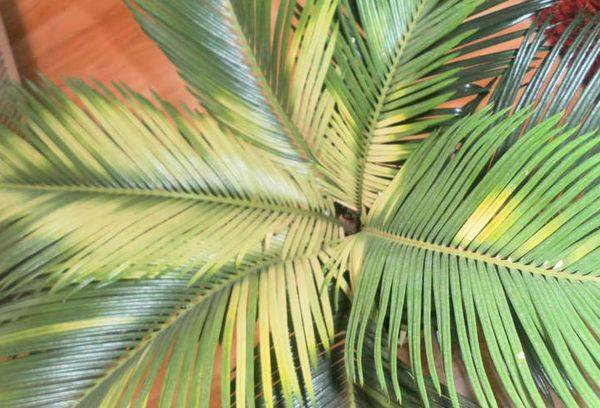What care does Tsikas need - a green guest from the tropics
Content:
Unusual houseplants are the pride and care of the owners. Tsikas is one of the brightest representatives of the Cygnus family, the care of which includes several nuances and features. Outwardly, it is a palm tree with a massive trunk and characteristic leaves emerging from the crown.
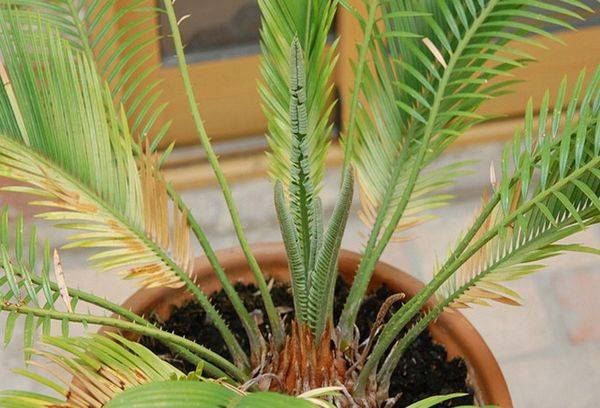
Tsikas Siamese
Description and Features
Palm cicada is a plant with an ancient history and attractive appearance. The time of its origin is the Mesozoic era, which is comparable to fern crops. Many experts catch the external resemblance of cicas just with fern.
The scientific name of the plant is Cycas, sago palm or bent Cygnus. The genus of cycas is approximately 200 species, some of which no longer exist in nature. Among the representatives growing today, there are cultural and wild varieties, both similar and completely different from each other.
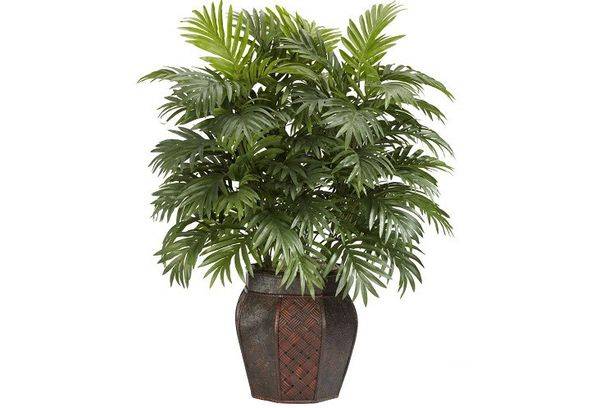
Tsikas Rumfa
The online magazine purityis.decorexpro.com/en/ recommends a cicas palm tree in every home as a beautiful and long-lasting decoration.
The environment for the spread of sago palm in nature is a vast territory from India to Japan, including Asia and the Pacific islands. Tsikas is a tall tree with a powerful trunk, from the top of which large cirrus-lanceolate leaves grow. Dead foliage covers the stem of the plant with a kind of carapace. In wildlife, a palm tree can reach a height of 3-4 meters and develop a trunk that reaches up to a meter in girth.
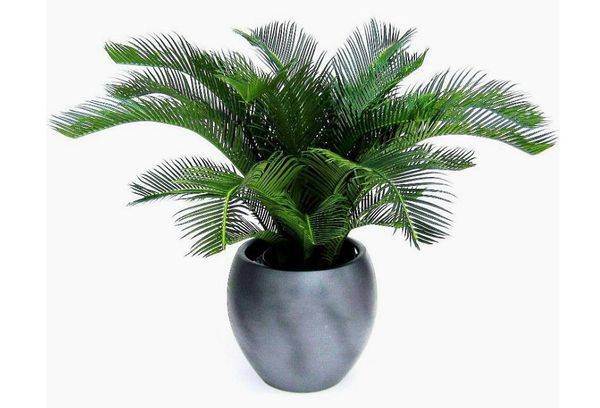
Tsikas average
Varieties
A room cygnus is peace, harmony and beauty, it is an exotic culture that always reminds of rest and summer. Florists prefer palm trees due to the wide variety of species and shapes.
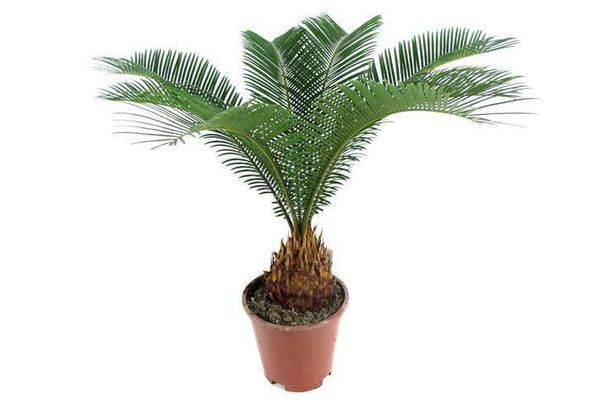
Tsikas Green Revolution
For home cultivation, several of them are most suitable:
- Revolutionary. The distribution area of this culture is Southern Japan. This plant is tall, with a thick trunk and long unpaired leaves. They are densely located on the top of the head, at a young age the leaf is pubescent, with time it becomes darker, bare and glossy. This is the most popular home-grown species.
- Cicas cochlea, or curled. This plant, reaching a height of 2 to 3 meters. The trunk is columnar, the leaves grow in length up to 1.5-2 meters. The young leaf is first directed upward, with age, its location changes to horizontal. Cirrus leaf plate, consisting of a large number of closely spaced lanceolate "fingers".
- Tsikas is average. This species in the wild extends up to 7 meters and above. Long leaves are gathered in a bunch on the top of a powerful trunk.
- Rumph. The birthplace of this is Australia. The plant can reach a height of 15 meters. Two-meter leaves of a linear-lanceolate form grow on it in bunches.
- Tsikas Siamese. The average height of this palm is 2-2.5 meters. A characteristic feature is the trunk, thickened from the base to the middle, and then tapering. The leaf is cirrus, bluish-green in color, growing to a meter in length.
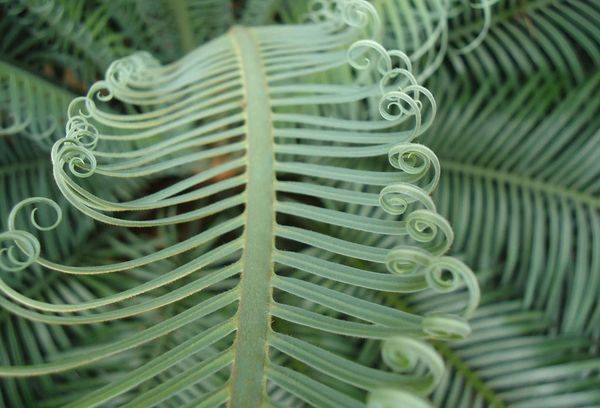
Snail-shaped cicas
Domestic palm trees of cicadas are lower than wild ones, stretching up to 80-100 cm. The plant is characterized by a slow pace of development. Over the year, it grows by 2-3 cm and produces only one row of leaves.
The young leaf of cicas has a bright green color and is slightly pubescent. Over time, it becomes smooth and shiny, acquires a dark green hue. At home, the palm tree does not bloom.In greenhouses, specialists are seeking not only budding, but also the ripening of seeds on female plants.
Containment conditions: light and soil
In the store you need to take a room cicada with a healthy and strong trunk, on which 3-4 leaves are well developed.
In order not to lose an unusual and expensive plant, you need to properly care for cicas:
- Location and lighting. Cygnus, like many palm trees, loves light and water. Direct sunlight helps better growth. Tsikas will surely enjoy the south side of the apartment. In winter, additional illumination with a phytolamp should be organized around the flower: for good growth of foliage, a palm tree needs 12 hours of light. Some gardeners plant cicada for the summer in the open ground.
- The soil. The ideal base for cicas is a mixture of turf, leaf, peat and humus land, interspersed with charcoal and coarse river sand will not hinder. It is important that there is good drainage at the bottom of the pot.
Temperature, hydration and top dressing
The palm tree grows well at temperatures from 20 to 30 ° C, with heavy watering it calmly tolerates heat. Wintering should take place from +10 to +15 degrees. At the same time, hydration should be reduced so that the plant passes into the vital stage of dormancy.
Tip
It is better to water the cicada palm tree twice - for the first time slightly soak the soil, and the second time shed it plentifully. After the procedure, be sure to empty the pan from excess water.
In hot weather, palm trees require regular heavy watering and generous spraying. A humid microclimate is familiar to this plant; the cygnus responds to regular irrigation with a rich emerald color and new leaves. However, the palm does not tolerate fluid stagnation at the base of the trunk. To avoid this, you should water the flower often in small portions.
In the period of adaptation to new conditions of life, it is recommended to apply fertilizing to the soil containing potassium and magnesium salts.
Complex fertilizers are useful for cicas, they are applied during the period from spring to canopy. If a houseplant is grown under semi-illumination conditions, the dose is divided in half. In low light, only a quarter of the standard rate is applied. An excess of trace elements affects the external characteristics of the flower.
Tip
When spraying, purityis.decorexpro.com/en/ does not recommend getting onto the top of the bump, as the kidneys on it are highly likely to rot.
Reproduction and transplantation
Seating On an adult palm, from time to time, children appear with the help of which reproduction occurs. Experienced gardeners can achieve seed ripening, from which new palm trees can be grown.
If a shoot is found on the trunk of the cicas, it should be separated with a sharp knife blade from the mother plant. The cut point is dried and sprinkled with crushed coal. The baby is freed from the leaves and is treated with a fungicide solution. For the formation of roots - it is planted in the sand, for some time it is kept in conditions of high temperature and increased humidity.
Relocation. Tsikas is usually transplanted during active growth and development, that is, in spring or summer. If the palm tree has released a new leaf, then the transplant should be carried out a little later. The pot for cicas is selected high and wide so that the roots are freely located in it.
The first 5 years, the flower needs an annual transplant. An adult plant should be relocated every 3-4 years.
Tip
Experts recommend draining the soil for cicas throughout the volume using expanded clay chips and coarse sand. Good drainage will not allow fluid stagnation at the trunk and in the roots of the plant.
Growing problems: why the leaves turn yellow in cicas
Palm cicada is a strong and drought-resistant plant that is rarely affected by diseases and pests. Sometimes a mealybug, scutellum and spider mite parasitize on a flower.
Important
Bent Cycas - a beautiful houseplant, but it contains neurotoxins.Contact with the flower and its juice in children and pets often causes severe poisoning. Therefore, cicada should grow out of reach of them.
If the leaves of the cicas are yellowed, then this indicates errors in care:
- the tips of the leaves turn yellow - the plant is undernourished;
- a new leaf turned yellow - excess watering and excessive fertilizer;
- old foliage turns yellow - there are rot on the stem or moisture in the pot stagnates;
- yellowness appears on the lowest leaves when overdrying or, conversely, excessive watering;
- cicasa dries if the room is too dry and the temperature is always high;
- also leaves turn yellow when alkalizing the soil and the wrong composition of the soil.
Other problems:
- Due to the insufficient mineralization of the soil and with a lack of nutrients, short new leaves grow in the palm, crown renewal slows down, and the trunk weakens.
- Deterioration of the appearance and lethargy of foliage often occurs with problems with the root system.
- A flower does not release leaves for a long time if it is not sufficiently rooted or lacks sunlight.
- The appearance of brown falling leaves occurs when the roots and trunk rot.
Excess fertilizer is washed out of the soil with regular watering. Each time, abundant watering should be carried out, after which the pan should be freed from surplus.
The soft trunk of a cicas is a signal of help. The appearance of brown spots and softness at its base indicates the decay of the plant. If the upper part of the cone trunk has become soft, this means that the process of decay has spread to the whole flower and has already affected its top. In such a situation, death is most often inevitable. Experienced flower growers recommend not to throw out the plant, but try to grow new seedlings from healthy tissue.
Tip
Take cicadas to the balcony or to the street should be gradual. Without adaptation, the palm often reacts negatively to excess light.
Rescue measures from decay, yellowness and falling of foliage:
- First of all, all yellow and brown leaves are removed.
- If there is a darkening on the trunk and softness is felt, it is necessary to clean this place to a healthy tissue, then dry and treat with garden varieties.
- If the process of decay progresses on the roots, then the plant should be removed from the pot, freed from the soil, carefully examined and cut off the defective parts of the root. The peeled rhizome is soaked in the root. Next, the plant is planted in sterile soil - sand or perlite.
The recovery period takes from several months to six months. If the rotting process spreads further, it is recommended to carry out sanitary pruning again.
Wax coating is a natural protection of palm trees from harmful insects. If infection does occur, then the plant is treated with insecticides, and visible individuals are collected manually, with a damp sponge. Repeated treatment is carried out until complete recovery.
A palm tree in a pot looks spectacular, bright and unusual. Tsikas grows slowly, but with proper care and care it will be a long time to please its owner with a strong trunk and a magnificent crown.
